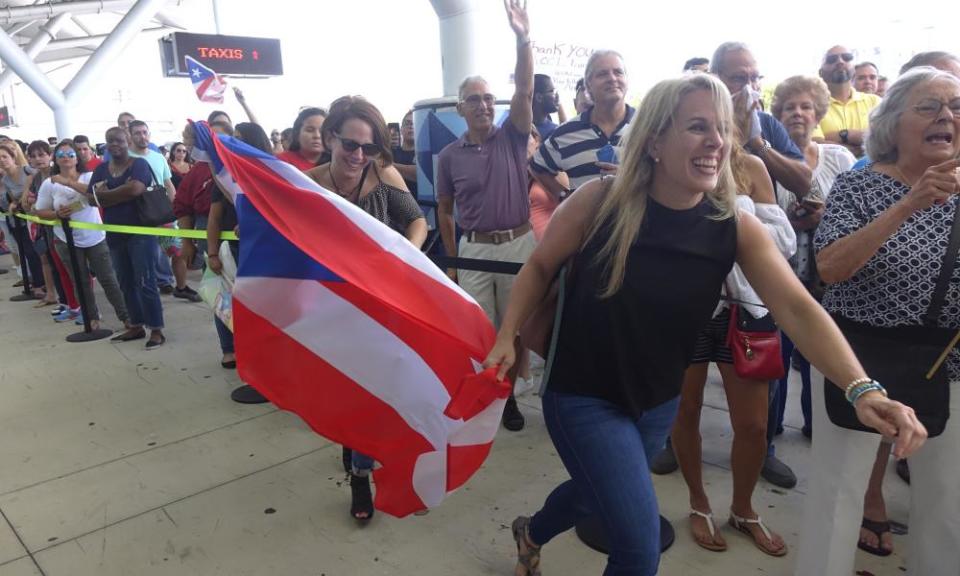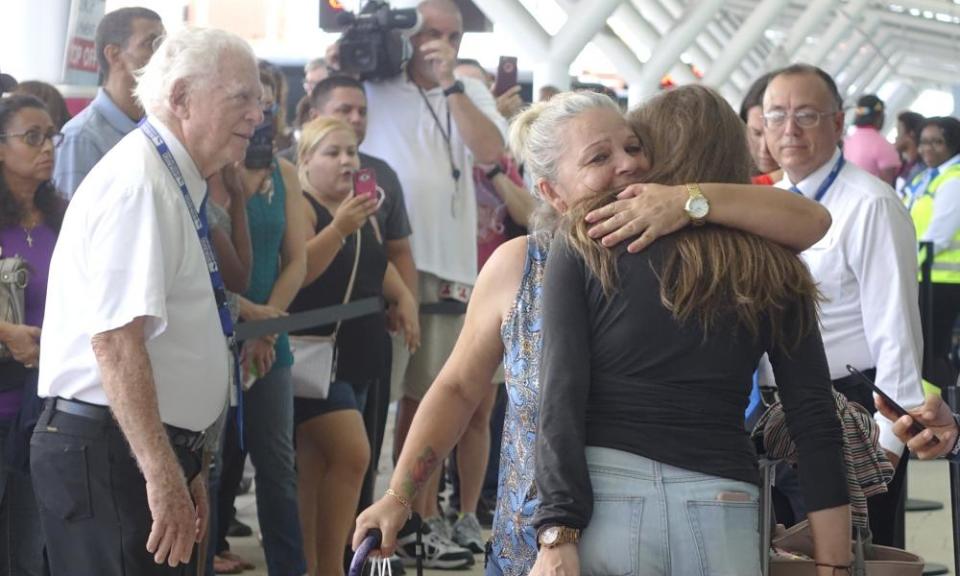Arrival of Puerto Ricans post-Hurricane Maria could have big impact on Florida
As many as 100,000 people are arriving from Puerto Rico, potentially transforming the Sunshine State’s housing, education, employment – and politics

These are long days at Orlando international airport for Ana Cruz, coordinator of the city’s Hispanic office of local assistance, who has greeted thousands of displaced Puerto Ricans fleeing the devastation of Hurricane Maria.
Three weeks after the monster storm ripped through the US territory, Cruz is becoming a key part of Florida’s response to the gathering pace of one of the largest migrations in modern US history by providing an empathetic welcome to distressed families at the airport’s disaster relief centre.
“They’re in a horrible situation,” said Cruz, originally from Caguas, on the east of the island. “People are arriving with nowhere to stay, no family here, no funds, nothing but the clothes they’re wearing. They just wanted to get out. They’re still shaking, still crying from the nightmare that happened.”
In just one day this week, Cruz said she met more than 600 evacuees on packed flights from San Juan, and directed them to tables where various governmental and aid agencies offered help with shelter, clothing and food, enrolling children in local schools and advising on job opportunities.
It was a scene repeated many times across the state, with thousands more arriving on flights and cruise ships to cities including Tampa, Miami and Fort Lauderdale.
“We were well prepared, but what happened in Puerto Rico … nobody expected it to be this bad,” said Cruz.
Puerto Rico is still reeling: 85% of the island’s residents lack electricity, 40% are without running water, and neither service is expected to be fully restored for up to six months; hospitals are overwhelmed; jobs have been lost and homes destroyed.
With conditions still tough, many Puerto Ricans – as many as 100,000, by some estimates – are heading to Florida.
Some aim to return as soon as they can, but others are likely to stay, and their arrival may have a significant impact on everything from housing, education and employment to the state’s political landscape.
Virginia Román, 87, reached Fort Lauderdale a week ago after several miserable days at her powerless retirement condominium in Rio Piedras, and is staying with her daughter Maritza Jimenez. For now at least, she has no intentions of returning to the island.
“She’s was in tears thinking about everything she left behind – her home, her family, her friends, the island, and the devastation,” Jimenez said.
“It warms our hearts to see how Florida has come to help Puerto Rico and we’re beyond happy they’re opening doors to American citizens and helping our neighbours. Because the recovery on the island will be so extensive we hope that help doesn’t die out,” she said.
Surveys have suggested that between 10 and 14% of Puerto Rico’s 3.4 million people are considering moving to the US mainland, said the US congressman Darren Soto, Florida’s first Puerto Rican elected to Washington.
“Only time will tell whether we have enough resources because right now it’s uncertain how many people are coming,” he told the Guardian.
“We’re doing our best to meet the challenges we expect to occur with a major relocation. Our schools are enrolling children even if they don’t have all their paperwork, we’ve extended two months of food stamps, our hospitals are ready to take in seniors, we’ve opened a shelter for those who need short-term housing,” he said.

But even before the storm, large numbers of Puerto Ricans were already helping to reshape central Florida’s economic and political landscapes. Fleeing the island’s $73bn debt crisis and increasingly bleak employment prospects at home, many families have moved to the Sunshine State, especially in Orange and Osceola counties, which Soto represents.
The Democratic politician said the newcomers will have been closely watching Donald Trump’s response to the hurricane crisis, particularly his “tone-deaf” tweets criticising the San Juan mayor, Carmen Yulín Cruz – and will have been angered by what they saw.
“I can tell you President Trump’s tweet attacking many on the island will be a major factor in how a lot of folks arriving here will perceive the political system,” he said. “Those tweets are like a spectre overshadowing a lot of other efforts, at least in the minds of many people I’ve spoken to.”
With more than a million Puerto Ricans now living in Florida, according to the Pew Research Centre, that could have significant implications at the ballot box in a state won by Trump in the 2016 presidential election by fewer than 113,000 votes.
“Historically our biggest elections are decided by one point so any shift of a couple of hundred thousand people can be a tipping point,” Soto said.
The non-partisan voter advocacy group Mi Familia Vota had already predicted Florida’s Puerto Ricans would overtake Cubans as the state’s largest Hispanic voting bloc by 2020.
“The shift was coming – [now] the timeline has moved up,” said Esteban Garcés, the group’s Florida director, who added that surveys last year showed those who came from the island were inclined to stay.
“Of course this was before Maria, but just about every Puerto Rican who was a new arrival said they had zero plans to return, that they were interested in finding employment opportunities that didn’t exist on the island.”
Garcés also noted that Florida’s Republican governor, Rick Scott, eyeing a seat in the US Senate when his term ends next year, was quick to welcome displaced Puerto Ricans by approving state resources and granting concessions such as in-state tuition rates for higher education students.
“It’s a political calculation,” Garcés said. “If you don’t prepare for this influx, if you discard this community like Trump has discarded Latinos as a whole, there’s a lot of fixing to do.”
School districts in central Florida, meanwhile, are expecting some of the biggest changes. Kelvin Soto, chairman of the Osceola school board, said the county expected to absorb at least 2,000 new students, lifting the population of its 69 schools to above 60,000.
“Every plane that leaves Puerto Rico is full, 80% land in airports in Florida, and the largest community of Puerto Ricans in Florida is in Osceola County,” he said, adding that one elementary school had already hired two qualified bilingual teachers from the Maria evacuees.
“It’s going to be tight in terms of housing, but these are good people and we want to get them back on their feet so they can go home when the time is appropriate for them – or they become part of our community,” he said.

